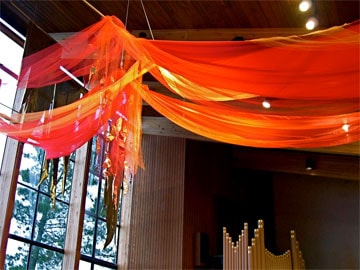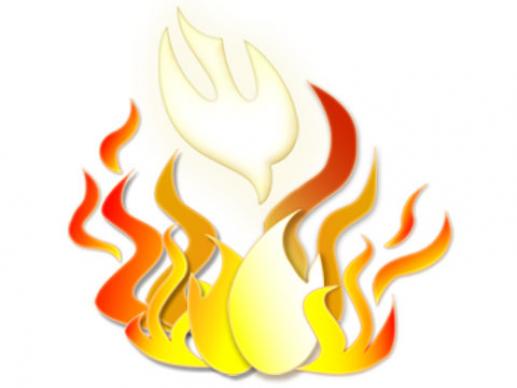There is a song for everything, as you probably know. Whenever I recall near-disastrous events involving candles and acolyte sleeves, the song “This is a Church on Fire” pops into my head. It’s not so funny when it involves a real fire, but the metaphor is a good one for the day of Pentecost. Pentecost Sunday represents an ending as well as a beginning: the end of the “Great Fifty Days” of the Easter Season (Pentecost means “the 50th day” in Greek) and the beginning of the commemorations of the early church. Pentecost also gives us an opportunity to ask ourselves the question, “What is our community ‘on fire’ about?”
For the early church, Pentecost was the second most important part of the Christian year after Paschaor Easter. Originally, it commemorated both the Ascension of Jesus and the descending of the Holy Spirit, but became two distinct celebrations by the end of the fourth century. (As Christianity became legal, there was no reason not to have as many celebrations as possible.) Pentecost also became a favorite time for baptisms with its focus on the work of the Holy Spirit within the church and within our lives. The holy day continues to be a wonderful celebrative time for rites of passage including baptism, confirmation and the reception of new members.
Whenever we engage in important ritual, we need to make it “rich-ual.” Asking ourselves how music, visuals and action can enhance what we are doing can lead to some simple decisions that deepen our experience. A congregation can mirror the gathering of the ancient community by having the baptized, confirmed or new members stand in the center and asking the community to face them for a blessing prayer—even extending hands toward them in an ancient gesture of blessing. Singing an invocational song before the ritual (“Veni Sancte Spiritus” or “Come, Holy Spirit”) with repetition can let us sink deeply into the moment. If you have people who can speak another language, invite them to say, “Come, Holy Spirit!” in multiple languages above the singing.

Using red fabric draped above the congregation can create a dramatic symbol of Pentecost in worship.
Photo courtesy of Marcia McFee.
Although “tongues of fire” is the most commonly used image, metaphors for the work of the Holy Spirit are many—water, wind and doves. One of my favorite traditions from Italy is the dropping of red rose petals from the ceiling of the church to recall the flames of Pentecost. Indeed, Pentecost is a time for the dramatic in worship—wind sounds, red fabric draped in exciting ways above the congregation, percussive sounds growing in intensity or even delicate wind chimes ringing as the air moves in the sanctuary.
I live in the mountains where fire is a danger this time of year, so I know fire also needs fuel to burn. This metaphor of fuel brings another set of questions to my planning: What fuels the fire or fans the flames of our church’s ministry? Compassion, love, hospitality, a desire for justice … to name just a few. Experiment with creating a litany, or a collection of stories or testimonials, that can communicate these characteristics and light a candle for each one.
Whatever you do to focus worshippers on the movement of the Spirit in our midst, remember the question: What is stirring within us? What is our passion for ministry? What sets us ablaze (or at least warms our hearts)? This can give a theological and missional undergirding for worship celebrations, providing a “why” for the “what” of worship planning.
May the Holy Spirit work in surprising ways in your church this year!
*McFee is a director of music and worship. She served as director of worship for the 2008 and 2012 General Conferences.
First published May 2010 at UMC.org.

